Martinů
in Paris: A Synthesis of Musical Styles
and Symbols
By
Erik Anthony
Entwistle
III. Of Folk Tunes, Pastorals, and
the Masses
Russian melodies and motifs, which
in Petrushka still provide
the main supplementary material,
here constitute [in Les Noces]
an essential part of the work, the
vernacular of the people, the spirit
that animates it and makes it one
of the most powerful expressions
of the Russian soul. At the present
time of slogans and trends, this
work, with its national and human
content, is particularly impressive.
This
assessment by Martinů of Stravinsky’s
Les Noces,
dating from the Czech composer’s first
years in Paris, offers us a window into
related aspects of his own work. Like
Stravinsky, Martinů discerned in
folk material the potential for powerful
expression and multiple layers of meaning.
In Martinů’s works stylized folk
tunes stand out from the short ostinati
and rhythmic cells that sometimes surround
them. This frank melodicism, so characteristic
of Martinů’s style, reflects not
only the composer’s national
origins and his desire to cultivate
Czech folk material, but also demonstrates
his motivation to express something
significant about the cosmopolitan environment
of Paris and society at large, using
materials with which he personally identified.
In many of the works written
during his initial years in Paris, Martinu
favored an approach that featured a
prominent tune in folk style, usually
standing in relief against a more rhythmic,
dissonant background. The folk component
is clearly reflected in the frequent
stepwise progressions and total absence
of chromaticism. There is often a sense
of triumph over struggle; the singing
quality of the tune represents humanity
in the most general sense, while at
the same time reflects Martinu’s nationalistic,
and essentially optimistic, approach.
There is also more than a hint of socialist
tendencies here, not necessarily in
a political sense, but certainly in
an idealized one, reflecting the power
and exuberance of the masses.
As Šafránek pointed out, “[Martinů’s]
feeling for people in the mass plays
an important part in his work and is
clearly shown in…Half-Time,
La Bagarre, La Rhapsodie,
and Field Mass, as well as, to
some extent, in the Double Concerto."
Half-time is indeed the first
work to demonstrate this feeling. As
a frenzied crowd of fans grows ever
more excited in the midst of a tense
soccer match, a melody emerges fortissimo
in the strings and harmonized in thirds,
an obvious folk-inspired gesture:

This tune clearly represents the crowd,
en masse, in an excited state.
It is the only extended melodic passage
in the entire piece, and as such vividly
stands out.
With La Bagarre this
trend continues, but with more interesting
implications. This is the work Martinů
boldly offered to Koussevitsky when
he spotted the conductor at a sidewalk
café in Paris, and which the Russian
conductor premiered in America with
the Boston Symphony Orchestra to critical
acclaim. Martinů submitted the
following program notes for that
occasion (the italics are mine):
La Bagarre is charged with an atmosphere
of movement, dash, tumult, obstruction.
‘Tis a movement in grand mass,
in uncontrollable, violent rush.
I dedicate the composition to the
memory of Lindbergh landing at Bourget,
which responds to my imagination,
and expresses clearly its aim and
evolution.
In this symphonic rondo, 2-2, I
have portrayed the tension of spectators
at a game of football (sic).
‘Bagarre’ is, properly speaking,
an analogous subject, but multiplied,
transported to the street. It’s
a boulevard, a stadium, a mass,
a quantity which is in delirium,
clothed as a single body. It’s a
chaos ruled by all the sentiments
of enthusiasm, struggle, joy, sadness,
wonder. It’s a chaos governed by
a common feeling, an invisible
bond, which pushes everything forward,
which moulds numerous masses into
a single element full of unexpected,
uncontrollable events.
It is grandly contrapuntal. All
interests, great and small, disappear
as secondary themes, and are fused
at the same time in a new composition
of movement, in a new expression
of force, in a new form of powerful,
unconquerable human mass.
But ‘La Bagarre’ is not descriptive
music. It is determined according
to the laws of composition; it has
its chief theme--as the human
crowd has its theme of enthusiasm--which
directs the movement. ‘La Bagarre’,
properly speaking, is a triptych,
in which the intermediate phrase,
usually free, is replaced (apparently
by a more melodious movement) by
a quicker tempo than that of the
first and third, ending in a violent,
presto coda.
It is
instructive to compare Martinů’s
description of La Bagarre
with the program notes to the third
work mentioned above by Šafránek,
La Rhapsodie (dubbed La Symphonie
at the premiere), a work possessing
distinct nationalistic overtones. Here
the annotator is obviously paraphrasing
Martinů’s own description and includes,
rather confusingly, a few direct quotes
(again, italics mine):
This "Symphony" performed
on December 14, 1928, for the first
time, was begun at Christmas, 1927.
It was written as a souvenir of
the first Czechoslovakian flag given
to the first Czechoslovakian regiment
at Darney, France, in June 1918.
"This ceremony, in which Raymond
Poincaré, the President of
the French Republic, and Edward
Beneš took part, was the first grand,
solemn act in the independence of
Czechoslovakia."
The dedication, "Pour
Darney, 30 juin, 1928," does
not hint at a programme for the
music. The symphony has a precise
form and construction, but not the
classic
form; nor has Martinů put four
movements into one. The symphony
is a grand march with a melodic
contrast. There is a crescendo to
the end which is based logically
and musically on the rhythmic theme
with which the symphony begins.
This rhythm is noticeable
in the percussion instruments. "Different
traditions of Czech music are found
throughout the work." The
inspiration is the same as that
of Martinů’s “La Bagarre”
("The Tumult"), an Allegro
for orchestra which was performed
in Boston by the Boston Symphony
Orchestra on November 18, 1927,
for the first time anywhere. Like
"La Bagarre," this symphony
pictures in tones a great movement
of masses, also "a mighty struggle
of events, hopes, efforts."
It should be noted that La
Bagarre was already finished
a full year before Lindbergh landed
at Le Bourget on May 21, 1927. Martinů
obviously took advantage of the Lindbergh
sensation by allying his piece to the
subject after the fact, raising the
question of Martinů’s original
programmatic intention for the symphonic
poem. In any case the extra-musical
content is generally described in the
composer’s program notes. This quote,
some of which seems to have been a bit
lost in translation, is an apt description
of the work in Martinů’s own words.
It demonstrates a social
consciousness in total contrast to,
for example, the ivory tower 12-tone
experiments of Schoenberg occurring
at that time. Socialist themes abound
in the description: the human mass is
unconquerable, and interests of the
whole outweigh individual significance.
Most tellingly, there is a reference
to being transported to the street and
the outcome of unexpected, uncontrollable
events. Given such descriptions the
piece might well have commemorated the
October Revolution.
The general title of La
Bagarre gives no hint of being inspired
by aviation. Indeed, the word bagarre
has often been translated as "tumult"
(as in the program notes above) but
more specifically means "brawl"
or "free-for-all", suggesting
a more combative tone ("bagarrer"
means to fight or battle). It
is puzzling why Martinů did not
change the title to “Spirit of St. Louis”
or something similar, but then again
his program notes deliberately downplay
the connection to Lindbergh’s triumphant
flight. Šafránek’s biographies offer
no further insight, merely
attempting to minimize the "machine
aesthetic" aspects of the work
without offering a substitute interpretation.
In both cases he tells us what La
Bagarre is not: "La Bagarre
is certainly not a description of the
landing at Le Bourget, with its mechanical
sounds and incidents", and "La
Bagarre is certainly no description
of Lindbergh’s landing or the echo of
mechanical sounds."
Turning now to the music itself,
the composer employs two by now very
familiar principle rhythmic motives
at the outset, a pattern of eighth notes
in syncopated groups of threes (secondary
ragtime), and an anapest (polka) rhythm
employed with ferocity rather than gaiety.
Of course the presence of jazz rhythms
here in the form of secondary ragtime
is not surprising, for this amazingly
popular music represented
the masses as a potent symbol of contemporary
taste. After introducing these rhythmic
elements, they are immediately combined,
providing accompaniment as Martinů
introduces the signature tune of the
work for the first time in the first
violins and
violas. As Martinů himself stated,
it is the theme of the human crowd’s
enthusiasm:
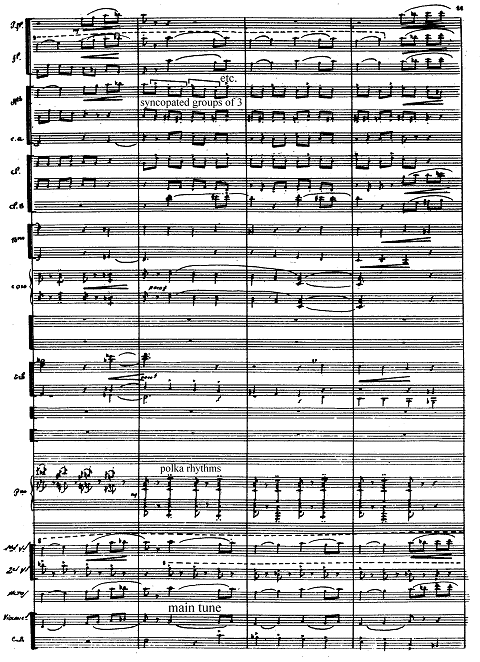
By briefly
examining two of Martinů’s ballets
written before La Bagarre
the seeds of this socially minded aesthetic
can be readily observed. In the fairy-tale
ballet Who is the Most Powerful in
the World
written just before Martinů came
to Paris, the mice swear allegiance
to one seemingly all-powerful figure
after another - the Sun (who apparently
reigns supreme), the Cloud (who eclipses
the Sun), the Wind (who blows away
the Cloud) and the Brick Wall (who stops
the Wind cold). But when the mice gnaw
away at the foundation of the Wall and
it collapses, they finally realize that
they are in fact the most powerful,
and celebrate their happiness in the
finale by dancing the polka.
This
parable with socialist echoes has a
counterpart in Martinů’s ballet-sketch
Vzpoura
(The Revolt), written in 1925. The libretto,
devised by the composer, is worth recounting
in order to help explain the significance
of the appearance of the folk tune at
the climax of the ballet. Šafránek’s
description is as follows:
The Revolt is a
revolt of musical notes (the low
notes are fat and bearded and the
tall notes are thin and pale), against
poor piano playing, bad singers,
a cracked, out-of-tune gramophone
and dance music in night clubs.
All the notes have risen in protest,
the wireless announces, and a general
strike of notes has been proclaimed.
This leads to unemployment among
musicians; Stravinsky retires to
a desert island, authors’ benefit
societies go into liquidation, and
makers of musical instruments switch
over to the making of children’s
toys. A composer appears on the
scene who wishes to compose, but
nothing occurs to him. Behind the
scenes a girl’s voice is heard singing
a folk song - the best
would be (according to Martinů’s
instruction): ‘Music-makers, what
are you doing?’ The girl, dressed
in national costume, comes nearer;
the composer listens, is fascinated
and writes, while behind him there
rises the white-robed figure of
Inspiration. The notes
pop out their heads at the sides
of the stage, curious to see what
is going on, and Inspiration draws
them together. The notes return
two by two, exactly with the theme
of a fugato, gradually give in and
start dancing. The whole ensemble
(bird, dog, mice, a Spanish dancer,
street singers, gentlemen in evening
dress, a lady in evening dress,
Harlequin and his beloved pupil,
a music teacher) enter the stage
and dance with the composer, with
the girl in national costume and
with Inspiration.
Here is the familiar theme of revolution,
played out in an absurd context, with
a rallying cry in the form of a folk
tune that unites the rabble. The following
example shows the tune that no doubt
represents the composer’s inspiration
after hearing the girl’s song, in the
appropriately simple and uncluttered
key of C major:
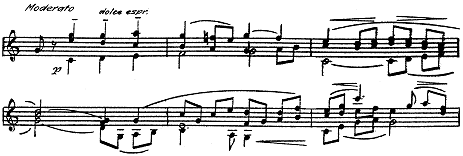
The joyous finale that follows
comes complete with references to the
"Hallelujah Chorus" from Handel’s
Messiah.
But beneath all of the humor and exaggeration,
Martinů is making a serious aesthetic
statement about the value of folk music
in the din of musical modernism. Only
a folk tune, with its straightforward,
diatonic melody, seems capable of restoring
normalcy, indeed a sense
of humanity, to the chaos.
It is clear, if perhaps surprising,
that the aesthetic stance of such works
as Vzpoura, La Bagarre,
Half-time and La Symphonie
also extended to Martinů’s chamber
works of the period, where he experimented
with similar approaches
to form and content. Martinu at this
time did not approach chamber music
as an abstract, "pure" art,
but enthusiastically cultivated extra-musical
themes in this branch of his output
as well. In the String Quintet, finished
October 5,
1927, this is especially evident, and
with good reason. In the previous month
Martinů had written to Václav Talich
about a new work to be composed especially
for him, as an alternative to La
Bagarre which had
already been reserved for Koussevitsky:
"I cannot fix an exact date when
I shall finish it. It is called Décollage,
i.e. the take-off of an aeroplane from
an airport; it is a sharp Allegro
con brio lasting about seven minutes."
As it happened Décollage
was never realized; it seems that the
string
quintet emerged instead. Perhaps Martinů
realized that three works in rapid succession
with airplane themes would be a bit
much (he had recently completed the
mechanical ballet Le
Raid merveilleux about
the doomed flight of Nungesser and Colli
who, after Lindbergh, had unsuccessfully
attempted to cross the Atlantic).
There is ample evidence that
Décollage indeed morphed
into the String Quintet, or, at any
rate, the work’s first movement, which
dates from the same time he wrote to
Talich. The first movement is indeed
an Allegro con brio (though it
lasts barely 6 minutes rather than seven).
Furthermore, throughout the movement
the writing for the five strings is
remarkably orchestral in conception,
perhaps further
betraying its origin, although Martinů
at this time had a penchant for overloaded
textures in his chamber pieces. More
to the point is the musical substance
of the movement itself, where the machine
aesthetic is represented by two distinct
ideas that open the work.
The first begins as a rocket gesture
in triplets ascending a d-minor arpeggio,
quickly followed (and opposed) by swirling,
chromatically descending triplets. This
musical idea reflects the laws of melodic
and natural gravity, and could easily
represent the distilled essence of an
airplane flight: a dramatic takeoff
followed by a more measured landing.
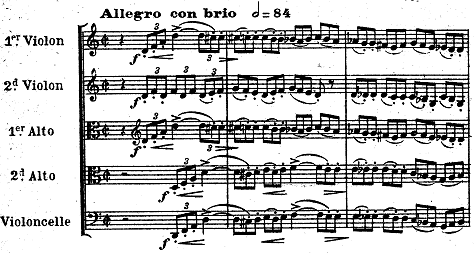
This recalls similar passages in La
Bagarre, as seen in the following
example from the beginning of its development
section:


The main concern here is with the melodic
element, which, as in La Bagarre,
appears amidst the busy rhythmic texture
already established. It functions as
a second subject, in the parallel major,
and clearly expresses something similar
to its counterpart in La Bagarre,
which it fairly resembles. It is definitely
of the diatonic, largely stepwise, folk-inspired
type favored by the composer. Even the
ascending scale in the cello part recalls
the descending scale patterns in the
corresponding passage in La Bagarre:
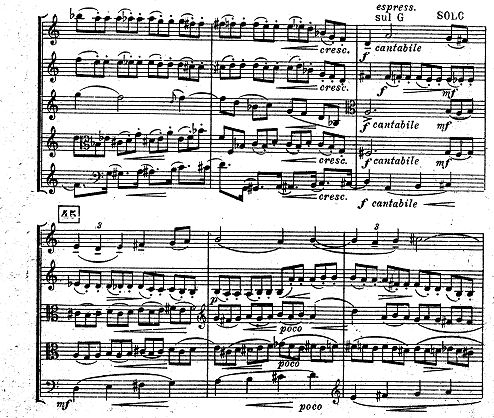
After struggling against the ceaseless
buzzing of the chromatic triplets the
tune breaks free with a final "rocket"
gesture, and all five instruments are
brought fully aloft in a breathtaking
climax. One imagines that the airplane
has soared into the sky, and with it
the human spirit:
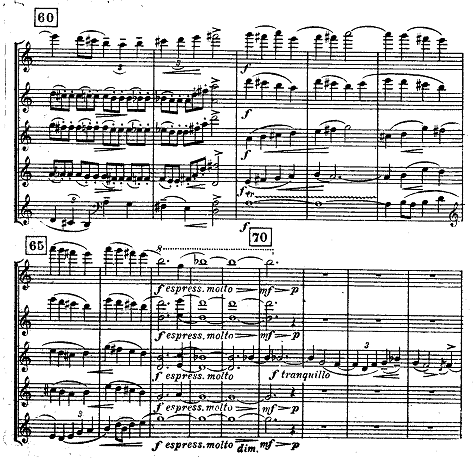
In the finale (a typical polka-like
movement in 2/4 time), the opening theme,
which dominates the entire movement,
is transformed through simple augmentation
into a climactic hymn capping the entire
quintet. The added counterpoint, with
its close imitation, increases the fervor
and intensity of the work’s peroration.
Once again the presence of the "big
tune" represents the collective
voice of humanity having the last word:
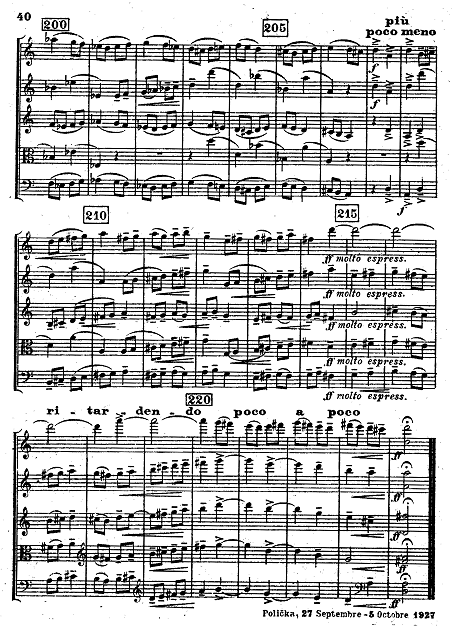
Martinů’s
most famous chamber work from this
period shows a similar tendency. In
the slow movement of the String Quartet
No. 2, a step-wise melody is featured
in the movement’s climax, with the typical
indication of espressivo molto
underlining its significance:
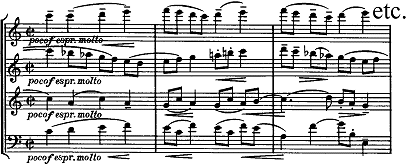
As late
as 1933 Martinů used this
portentous style in the conclusion to
his Piano Quintet No. 1. This grand
melodic apotheosis strains the chamber
music texture with huge, accented, orchestrally
conceived chords in the strings and
a resounding piano part to match. It
is so bombastic that
Martinů may well have had his tongue
in his cheek when he wrote it, parodying
the enthusiasm of his own earlier style:
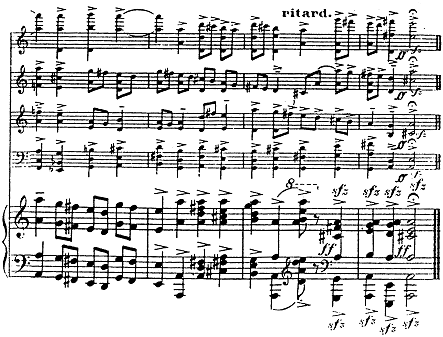
Indeed,
one is reminded by the previous example
of another work, Martinů’s piano
Prelude written in 1929 to celebrate
the opening of the new theater in his
hometown of Polička. This constitutes
an outrageous parody of Mussorgsky’s
Great Gate of Kiev
from Pictures at an Exhibition.
The unusual harmonic progressions invoke
the style of Mussorgsky’s "empirical"
harmony, providing additional
humor. The last four bars also parody
a phrase from the “big tune” in Martinů’s
La Bagarre,
which appears here at a much slower
tempo:

It is
not surprising that the spirit of Mussorgsky
finds its way into Martinů’s works.
There is more than a hint
of it in the melodies quoted earlier
as well, and without humorous intent.
He noted, and no doubt shared, Stravinsky’s
sympathies in this regard. Writing about
Les Noces,
Martinů observed that “the shade
of Mussorgsky lies on these melodies,
which are transposed into
the present epoch, the present tendencies
and sensibilities of the modern man."
Thus Martinů can be observed leaning
as much toward Russian folk stylization
as Czech. He clearly sympathized with
the pan-Slavic approach favored by his
predecessor Dvořák, as well as
that other famous Czech Russophile,
Leoš Janáček.
Most
of the long-breathed melodies examined
so far are interesting in that they
lack any syncopated qualities. Martinů
clearly wants these tunes to sing, and
not dance, giving them
a larger-than-life quality and allowing
them to stand out symbolically from
the rest of the texture. When such tunes
are syncopated and the notes themselves
made more rapid, however, a dance-like
character of completely different sensibility
results, as the following example from
the Duo No. 1 for violin and cello demonstrates:

If this example resembles the
rhythmic approach observed in the previous
chapter, other
of Martinů’s dance tunes in folk
style, while rhythmic in quality, remain
untouched by syncopation. As the following
example from the Commedia
dell’ Arte suite demonstrates,
this is part of a process of simplification
that can be observed in certain of the
composer’s folk-inspired works, particularly
from the 30’s. Here, the resemblance
of this polka tune (played by solo viola)
to the Russian Dance from Petrushka
is unmistakable:


After these brief examples it
proves instructive to examine in detail
a short, complete work in Martinů’s
folk idiom. A good example is the second
movement from a cycle of four short
piano pieces entitled Quatre
Mouvements, written
in 1929. The melody is of the non-syncopated
dance type, similar to the one just
quoted.
The entire work extensively features
what the composer would have referred
to as “Czech elements”, and perhaps
not coincidentally. It was dedicated
to Martinů’s compatriot and future
biographer Miloš Šafránek.
In the second movement various rhythmic,
melodic,
and harmonic characteristics provide
a veritable catalog of Martinů’s
approaches to folk stylization. The
following annotated example reproduces
the entire movement:
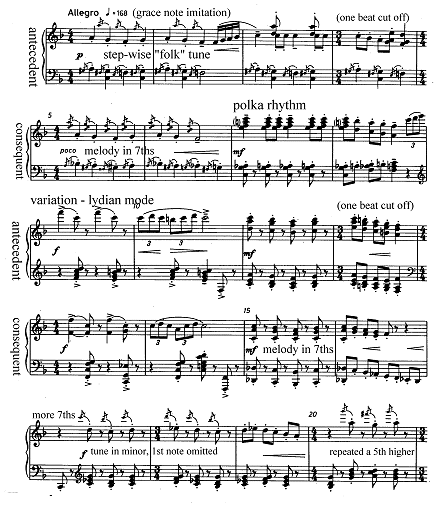
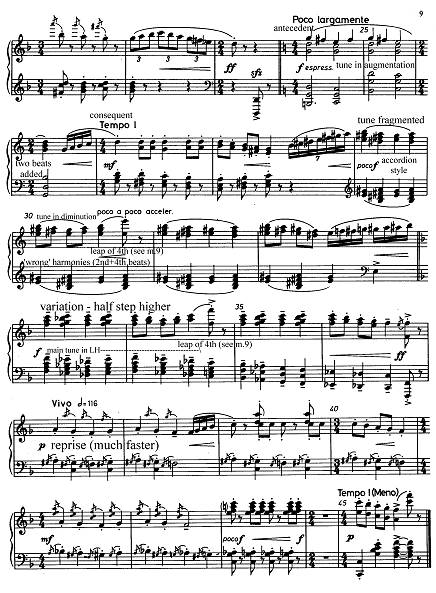
Martinů
works with an extremely simple, step-wise
melody in clear folk style.
It may well be an actual folk tune rather
than a stylization, and it could easily
be set to a children’s nursery rhyme.
There is more than a hint of the polka,
too, especially evident in the rhythmic
patterns found in measures three and
seven. Martinů
plays with the tune in a variety of
ways. The melodic structure consists
of simple antecedent/consequent phrases
(actually, the melodies in each phrase
are nearly identical, but Martinů
treats them gesturally as a complementary
pair). Immediately the
composer begins to embellish the basic
line through various means. First are
the pervasive grace notes, which immediately
muddy the waters, both melodically and
harmonically. As also seen in the previous
example reminiscent of Petrushka,
this ornamentation is a definite type
of folk stylization - in faster tempi
it recalls a playful "Gypsy"
style of embellishment, and in slower
tempi it recalls an ornamented vocal
line. Stravinsky was fond of both types
in his early ballets for Diaghilev and
other works such as the Soldier’s
Tale,
and Martinů was clearly influenced
by this approach.
The piece begins in unison, while the
right hand’s grace notes imitate the
melodic line from one beat behind, complicating
the presentation of the simple tune.
In the consequent, the left hand is
no longer in unison with the right,
clashing with seventh intervals and
compounding the "wrong note"
effect of the grace notes. In the third
bar, fifths D-A added to the right hand
complement the C-G in the bass, creating
the unrefined, "folk" sound
of open fifths. The biggest surprise
comes in the fourth bar, when a sudden
switch to triple meter causes the phrase
to be cut off prematurely, leading directly
into the consequent phrase. This humorous,
lopsided effect is exploited in the
rest of the piece. For example, at the
switch to minor (measure 17) the insertion
of two triple-meter bars creates two
phrases of 4+3+3, extending this disorienting
effect.
At the Poco largamente,
the tune returns in augmentation, where
it is also extended by two additional
beats. At this point the original tune
has undergone further changes. It is
back in major (G this time), but has
been transposed to the first scale degree
instead of the original third degree
(the consequent however re-orients
itself melodically). At measure 29,
a sudden modulation to E major features
alternating tonic and dominant-seventh
chords which creates a wheezing accordion
effect. Martinů used the accordion
itself in many works, including two
operas written at that time,
Les Larmes du couteau, and Les
Trois souhaits.
As noted in the example, the harmonies
do not always coincide with the melodic
shape, enhancing the crude, primitive
effect. Martinů was fond of creating
patterns in this way and letting them
pursue their more or less
independent paths. Here the melody is
now heard beginning at the fifth scale
degree and features a new variation
of the tune. At measure 33, yet another
variation heard half a step higher with
a poco a poco accelerando causes
the music to gain momentum, leading
into a much faster reprise. But the
anticipated flourish at the end is thwarted
in a typically humorous touch - the
frenzied dance is suddenly halted by
a 2/4 measure of rest, and the descending,
cadential portion of the tune has the
last word in a slower tempo. The persistent
grace notes and harsh dissonances evaporate,
leaving only a pure, final, perfect
cadence in the bass and soothing parallel
sixths in the treble. The piece, suddenly
stripped of all modernisms, ends like
a nineteenth-century polka in salon
style. This naïve gesture is very
typical of Martinů’s approach to
humor.
The overall harmonic palette
of this brief morceau
shows the pan-diatonicism typical of
Martinů’s pieces written in a stylized
folk vein. Though framed
by F major, the piece journeys through
c minor, g minor, G major, and E major
in a fluid approach to tonality. Strictly
speaking these are not harmonic "progressions"
but rather backdrops to the series of
pictures (variations of the melody)
presented in the different colors of
the various keys. Typical also is the
unbuttoned approach that this piece
favors, with wild, unpredictable flights
of fancy and emotional exuberance.
If the
preceding analysis shows Martinů’s
use of stylized folk melodies in a specifically
nationalist (i.e., “Czech”) vein, another
important facet of this aspect consists
of Martinů actually quoting his
predecessors Smetana and Dvořák.
There are many possible
avenues of inquiry here, but two characteristic
examples related to Dvořák will
suffice.
In the slow movement to his Violin
Sonata in d minor (1926), Martinů
recalls the slow movement of Dvořák’s
Cello Concerto with a similarly tender
melody. Here is one of Dvořák’s
phrases (piano reduction of orchestra),
followed by the opening of Martinů’s
sonata:
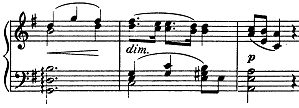
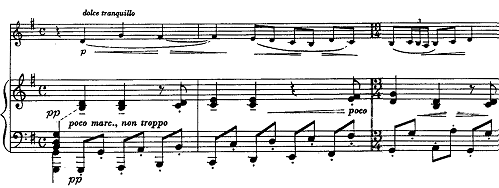
This heralds a movement that is unabashedly
romantic in conception - an uncharacteristic
departure for the composer writing works
such as La Bagarre during what
he coined an "era of dynamism."
If the previous example strikes
one as coincidental, the following should
prove more convincing. The first of
five Esquisses de danses for
piano (1932) is a polka in which several
musical ideas bear a striking resemblance
to Dvořák’s Slavonic
Dance Op. 46 No. 3,
also a polka. The two ideas in the separate
hands of the primo
part in the Dvořák are evoked in
different parts of Martinů’s short,
highly episodic movement. Dvořák’s
left hand melody is heard in Martinů’s
work in a kind of diminution in minor
mode, with the long held note “polka’d”
with rapid repeated notes in the characteristic
rhythm. All of this is supported by
another harmonically clashing Stravinskian
ostinato in the piano’s left hand:

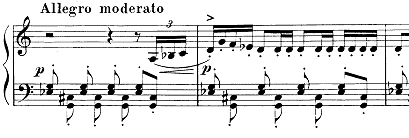
Later
in the Martinů piece a variation
on the idea heard in the right hand
of the Dvořák occurs, seeming to
confirm that the correspondence between
the Martinů and Dvořák in
this work is not merely accident or
coincidence. Interestingly, Martinů
shifts the groupings so
the slurs do not cross the bar lines,
but the agogics undoubtedly remain the
same for the listener:
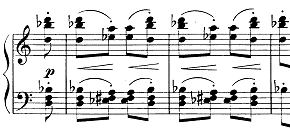
Of course Martinů’s intent cannot
be proven in these cases, but whether
the references to Dvořák are accidental
or intentional is perhaps beside the
point. In any case, it is clear that
the tradition of Czech musical nationalism
that Dvořák and Smetana helped
to establish remains alive and well
in Martinů’s works.
This leads finally to an examination
of the pastoral, which occupies a special
place
in Czech music and which Martinů
uses in a very striking way. The composer’s
use of music in pastoral vein is frequently
associated with the Martinů’s upbringing
in the rural Czech-Moravian highlands
known as the Vysočina. His bird’s-eye
view of the endless
stretch of fields and hills surrounding
the town seen from the top of the tower
of the St. James Church, where Martinů
spent the first eleven years of his
childhood, particularly springs to mind.
In truth, however, Martinů was
confronted by pastoral
images not only during his frequent
visits home but in Paris itself, for
the world or art and literature had
responded to the pastoral in a kind
of backlash against the speed and harshness
of modern city life, as the following
quote makes evident:
Fostered by a nostalgia for a bygone
world, seen as a consolation for
the violent historical disruption
of the War, and stirred by demographics
- an uninterrupted rural exodus
had led by the twenties to what
many perceived as an alarming hemorrhage
of the French countryside - the
period was beset by a heated debate
of urban versus rural. If French
literature, for one, witnessed the
revival of the regionalist novel,
which sang the praise of pastoral
life, a survey of the art exhibited
at the annual Parisian Salons during
the 1920s indicates that the number
of works devoted to urban themes
was actually limited compared with
the output of landscapes and peasant
themes.
This surprising phenomenon no
doubt helped to fuel and shape one of
the most important aspect of
the composer’s aesthetic. The idea of
the pastoral as an escape finds one
of its most characteristic expressions
in a comparatively insignificant work
by Martinů, the Sketches
for piano solo written in 1931. Here,
surrounded by yet another jazzed-up
polka, a rather obnoxious fox trot,
a quirky waltz and two works built up
from Stravinskian ostinati, appears
an exquisite pastoral, underlining the
idea of escape from the noise and rhythms
of modern existence. In this fourth
of six pieces, the chords float without
reaching true resolution, creating a
sense of open space without forward
motion. At the end of the following
excerpt, a mixolydian inflection helps
to avoid a standard cadence. The sound
is distinctly Coplandesque, remarkably
anticipating that composer’s pastoral
style:

The end of the piece utilizes
similar modal inflection. The final
cadence arrives after a pentatonic passage
evoking a shepherd’s flute in quintessential
pastoral style. This time the progression
reflects the Lydian mode, with chords
mostly in inversion and a pedal point
in the upper voice creating a tonally
ambiguous close. Again, there is an
avoidance of any sense of progression
in the traditional harmonic sense, despite
the presence of chords that should be
heard as tonic,
predominant and dominant. Indeed, when
listening to the last two chords it
is difficult to decide whether they
constitute an open-ended half-cadence
or a plagal one, since the B natural
seems to point toward C. Here Martinů
has apparently expanded upon
the traditional harmonic structures
of the pastoral without sacrificing
the essence of the style:

Further
examples of pastorals abound in Martinů’s
works, and here are two more typical
ones from the Commedia
dell’ Arte Suite.
In the first, the harmony remains fixed
in typical drone bass style while bucolic
figures in the flute complement the
oboe’s lyrical, folk-style tune. The
only irregularity is the five-bar phrase,
but this only enhances the open-ended
feeling evoking an imagined place where
time has no meaning:
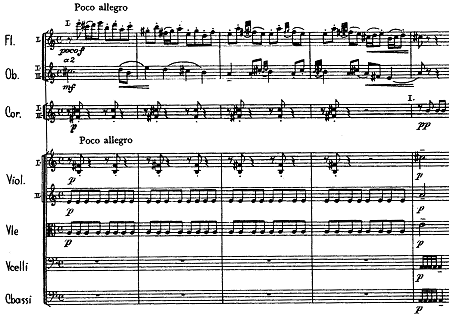
As the excerpt continues, more characteristic
features appear - the drone has moved
to the lower bass register, and the
modified tune is now harmonized in thirds
and sixths, offering a paradigmatic
pastoral image:
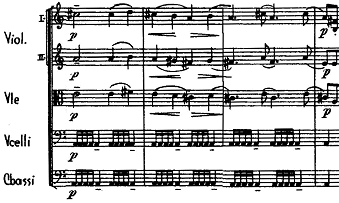
More sophisticated is the melody heard
at the beginning of the fifth movement
of the Suite. The triple meter and frequent
rests in the passage below offer a sense
of repose and flowing nonchalance. Somewhat
independent lines occasionally produce
the expected thirds and sixths, but
fourths and fifths are equally prevalent
(notice the parallel fifths in measures
five-six), as are the unusual phrase
lengths (three and six bars, until the
last two-bar ending). Though not entirely
within the realm of the stereotypical
pastoral, then, the musical effect of
the passage is essentially congruous:

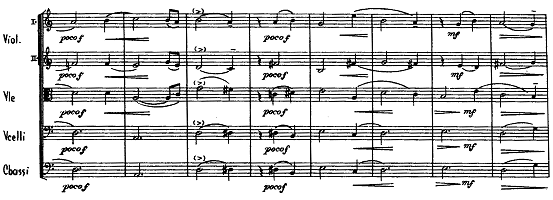
Often
the pastoral occurs metaphorically within
a Martinů work as a place of respite
surrounded by more agitated music, giving
it more expressive power as its vulnerability
becomes all the more apparent.
In a work such as the String Trio No.2
(1934), with its opening rocket theme,
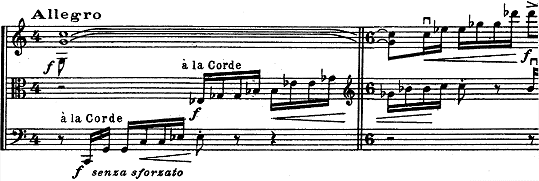
there soon appears, as an opposing
force, a lyrical second theme. This
idyllic folk melody, while again not
specifically a pastoral, nevertheless
functions as an escape from its agitated
surroundings: 
This lyric music is like a vulnerable
oasis of calm and beauty, standing out
all the more remarkably because of its
simple diatonicism. The juxtaposition
of these two extremes of style make
each that much more dramatic and compelling,
and this represents one of the composer’s
responses to the long established masculine-feminine
thematic duality characteristic of sonata
form.
Another remarkable example of
this approach occurs in one of the very
first pieces Martinů
wrote in Paris, the Concertino for cello.
In the midst of relentless rhythmic
passages derived from jazz and Stravinsky,
the cello is allowed a simple, very
expressive folk tune. Even while the
cello sings, military fanfares and shifting
triads à la
Petrushka can be heard,
pianissimo, in the background.
Here is the tune itself, with its Slavic
quality reminiscent of Mussorgsky:

The following excerpt from Le
Départ (a symphonic interlude
from the 1929 jazz opera Les Trois
souhaits) offers a useful comparison.
Here, Martinů inserts a very brief
pastoral passage, unaccompanied and
therefore unperturbed, that contrasts
with the dense, disturbed character
of the symphonic poem as a whole. The
pentatonic scale is once again called
into service to help create
the pastoral image, with Martinů
using melodic oscillations to help create
a sense of temporal suspension (these
are also slurred for emphasis). Unlike
the previous example from the Concertino,
this gently descending shape is not
a developed tune, but
sounds rather like a wistful, meandering
improvisation. Amidst the dissonant
bustle of the remainder of the composition,
this moment seems to reflect more gently
on the opera’s subtitle, "The Vicissitudes
of Life":

Three further examples show
an integrated
approach typical of Martinů’s slow
movements. In the opening of the Poco
andante from the Piano
Concerto No. 2, a noble melody is presented
in the first two measures with all parts
in diatonic agreement. This initial
restful gesture is soon threatened by
an increasing sense of tension in measure
three as the melody and bass clash harmonically,
with dissonant intervals formed in the
middle parts as well. The chromaticism
markedly increases in the fourth measure,
along with the dynamics, bringing the
intensity to its high point. The music
just as quickly retreats, however, with
a diminuendo and a falling chromatic
pattern bringing about an unexpected
shift back to the tonic in measure five,
via a perfect cadence:


A tender reminiscence of the melody
returns toward the close of the movement,
followed by a disarmingly simple piano
solo. Up until this point the solo writing
has been marked by unrelieved chromaticism,
but now all such vestiges have been
purged and the ear is finally comforted
with a gently rocking, diatonic passage
emphasizing thankful plagal progressions:

In the Andantino moderato
from the Serenade for Chamber Orchestra
(1930), a solo violin joins the
woodwind for a distinctly pastoral-sounding
timbre. The melody, with its almost
Mozartian lyricism shared by the solo
flute and violin, confirms the neoclassical
orientation of the piece suggested by
the title. It is largely diatonic, clear
and expressive, though lacking a strong
folk flavor. Indeed, the folk component
appears to have been sublimated in favor
of a more neutral melodic profile. The
passage begins simply in G major with
all parts in agreement, but the harmonic
structure quickly becomes muddied by
opposing polyphonic strands, threatening
the initial mood of total serenity.
The clarinet proves to be in the dominant,
not the tonic, while the bassoon begins
an ascending octatonic scale in a typical
oscillating pattern. The brief return
to G in measure seven provides a transient
moment of harmonic clarity before bitonal
and chromatic elements one again create
a dissonant departure. At the close
of
the passage order is at last restored
as G is once again established in a
perfect cadence that Martinů arrives
at through a gratifying reunion of all
parts. This passage is characteristic
in its use of octatonic, chromatic,
and otherwise contrasting scales
to regulate tension. As the amount of
density and dissonance increases, so
does the feeling of distance from home.
Finally Martinů clears the air,
lyricism reemerges unscathed, and traditional
harmonic underpinnings once again hold
sway:
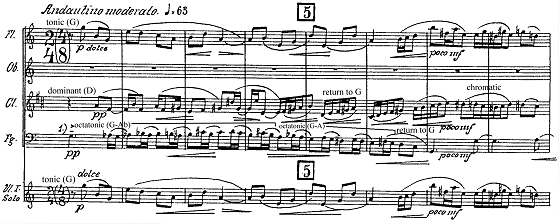
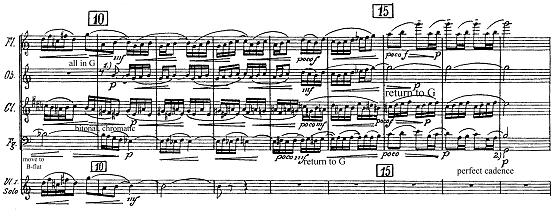
In contrast, the slow movement
of the String Quartet No. 5 shows a
more uniformly dissonant, quasi-pastoral
setting. It begins with a melancholy
tune in the first violin based on an
octatonic scale. As in the previous
example, the accompanying portion is
not based
on the scalar material of the soloist,
but has its own independent pitch content.
This is probably as close as Martinů
comes to an expressionistic style in
his works, with the lower three strings
approximating the atonal style of Webern.
The pastoral image can
also be discerned, however, in the lonely
wail of the violin solo. Despite the
modern musical setting there is a kinship
here to Berlioz’ use of pastoral imagery
to evoke despair in the slow movement
of his Symphonie Fantastique.
The ominous rumblings of the string
tremolandi can be interpreted
in this connection:
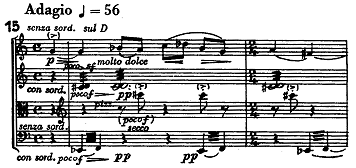
In examining
Martinů’s use of the pastoral,
and by extension his penchant for a
certain kind of distinctive, vulnerable
lyricism, it has been observed that
such moments, standing freely or threatened
from within, function as symbols of
refuge. There is no
doubt that they also contribute some
of the most striking moments in Martinů’s
music, standing out because of their
apparent simplicity but complex in their
overall meaning. This orientation in
Martinů’s works is clear, despite
the composer’s assertion
that "melody has changed its character.
It does not represent anything pathetic,
it is not romantic, it is not overfilled
with poetry, sentimentality, it is concise,
exact, expressive, it is a musical thought,
the expression of a musical theme upon
which it is necessary to build a work
within specific musical laws."
Certainly Martinů’s folk tunes
are “concise, exact and expressive”,
but in their very simplicity they acquire
powerful expressive potential.
With regard to the use of folk
tunes in general, it would not be an
exaggeration to draw a metaphor from
Martinů’s
everyday life in Paris, with its attendant
bustle and stress, and the rural roots
to which he was constantly drawn. Martinů’s
folk idiom, whether heroically emblematic
of the masses or symbolic of the refuge
and peace craved by humankind, seems
to capture this dilemma
of the modern man who at once hopes
to improve conditions of his reality,
but at the same time longs for escape.
It is an essential component of the
composer’s aesthetic, and offers a different
path from the problem-filled "metaphysics"
that
the composer denounced as pretentious
and meaningless. It is important to
remember, however, that for Martinů
this was no mere idealizing of the rural
“folk” from an urban dweller’s perspective.
The composer was after all a product
of that rural environment,
and he knew its harshness and limitations
all too well. Rather there is something
deeper at work, with the composer using
musical means to transform the simple
into the profound. In such moments Martinů
strikes a reasoned aesthetic balance
between the provincial
and the cosmopolitan, tapping into his
own rich cultural heritage to bring
forth a more universal message.
Introduction
I.
A New Beginning: Life In Paris
II.
How Martinů "Got Rhythm"
III.
Of Folk Tunes, Pastorals, and the Masses
IV.
Dvakrát Svatý Václave
(St. Wenceslas, Twice)
V.
An Aspect of Minor/Major Significance
VI.
Fin de séjour: Julietta
and Musical Symbolism
VII.Conclusion:
Martinů’s Parisian Legacy

